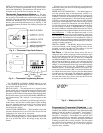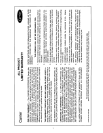
NOTE: If the thermostat is in Occupied mode and the Over-
ride button is pressed, the thermostat will go into Unoccu-
pied mode immediately. The thermostat will remain in Un-
occupied mode until the next Occupied start time.
Thermostat Programming Buttons — The ther-
mostat has programming buttons which are used to change
the set points of the thermostat, set the modes, and program
schedules. The programming buttons are accessible from un-
derneath the thermostat cover. To access the programming
buttons, pull on the hinged thermostat cover. See Fig. 3. The
programming buttons are: Mode, Fan, Holiday, Program, and
Set Clock.
The UP ARROW and DOWN ARROW buttons are used
to scroll through programming set points. The buttons are
also used to answer yes or no.
KEYPAD LOCK — The thermostat has a keypad lockout
feature which will not acknowledge front panel buttons until
the lockout sequence is entered. To disable or lock the key-
pad, press and hold the Override button. While holding down
the Override button, press the UP and DOWN ARROW but-
tons simultaneously. The ‘‘Locked’’’ icon will appear on the
display.
The thermostat is unlocked by performing the same pro-
cedure. Press and hold the Override button. While holding
down the Override button, press the Up and Down Arrow
buttons simultaneously. The ‘‘Locked’’ icon will be re-
moved from the display.
FAN BUTTON OPERATION — The Fan button selects fan
operation. When the fan is set to FAN ON, the fan will run
continuously for improved air circulation.
NOTE: When the thermostat is in Unoccupied mode, the fan
will run only during heating or cooling operation, even if the
fan is set to FAN ON, this is the energy-saving smart fan
feature.
When the fan is not set to FAN ON (no icon displayed on
thermostat screen), the fan will run during heating and cool-
ing operation only.
MODE BUTTON OPERATION — The Mode button se-
lects the operating mode of the thermostat. If OFF is se-
lected, the thermostat will not enter Heating or Cooling mode.
If HEAT is selected, the thermostat will only enter Heating
mode (if the room temperature is below the heating set point).
If COOL is selected, the thermostat will only enter Cooling
mode (if the room temperature is above the cooling set point).
If AUTO is selected, the thermostat will enter Heating or
Cooling mode based on the room temperature and the heat-
ing and cooling set points. If PROGRAM ON is selected,
the stored schedule is enabled and the thermostat will follow
the Occupied and Unoccupied schedules stored in its memory.
Auto-Changeover — When the thermostat mode is set to
AUTO, the thermostat will provide automatic changeover
from Heating to Cooling mode and Cooling to Heating mode
when required. The thermostat will automatically switch to
maintain the desired temperature setting. The thermostat does
not need to be manually changed from heating to cooling or
cooling to heating operation.
HOLIDAY MODE — The Holiday button places the ther-
mostat into Holiday mode. During Holiday mode, the un-
occupied set points are enforced. The number of days the
thermostat will be in Holiday mode can be set.
Set Clock — The Set Clock button allows the user to
change the time and day displayed on the thermostat. Press
the Set Clock button to enter Set Time mode. See Fig. 4. The
current time will blink on and off. Press the UP ARROW
and DOWN ARROWbuttons until the correct time is shown.
Hold down the buttons to quickly move through the time
display. The AM and PM annunciators will automatically
change. To scroll through by hours only, press and hold down
the fan button while pressing the UP ARROW or DOWN
ARROW buttons. To ensure the schedules are properly fol-
lowed, make sure thatAM or PM is correct for the time cho-
sen. When the correct time is shown, press the Mode button
to modify the day of the week. The current day will blink on
and off. Press the UP ARROW and DOWN ARROW but-
tons until the correct day is shown. Press the Set Clock but-
ton again to exit the Set Time mode.
Programming Thermostat Schedules — Be-
fore programming the thermostat, plan the thermostat daily
schedule. The schedule is dividedinto 7 days (Monday through
Sunday). Each day can have 2 (Occupied 1, Unoccupied), 3
(Occupied 1, Occupied 2, Unoccupied), or 4 (Occupied 1,
Occupied 2, Occupied 3, Unoccupied) time periods. Each
occupied time period has a start time, stop time, heating set
point, and cooling set point. The unoccupied time period has
a heating set point and a cooling set point. The unoccupied
time period is active whenever an occupied time period is
not active. Fill in Table 1 on page 5 as an aid to program-
ming the daily schedules.
Fig. 4 — Setting the Clock
Fig. 2 — Thermostat Front Panel Buttons
Fig. 3 — Thermostat Programming Buttons
2










